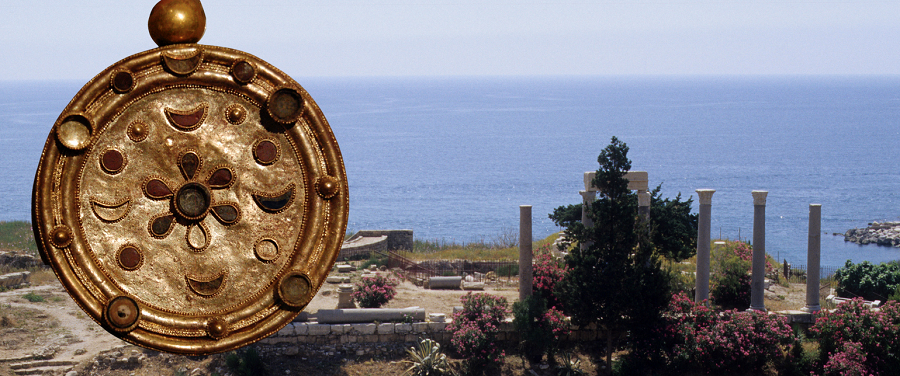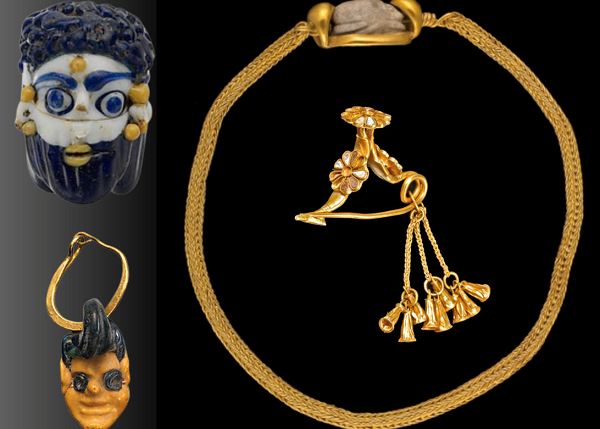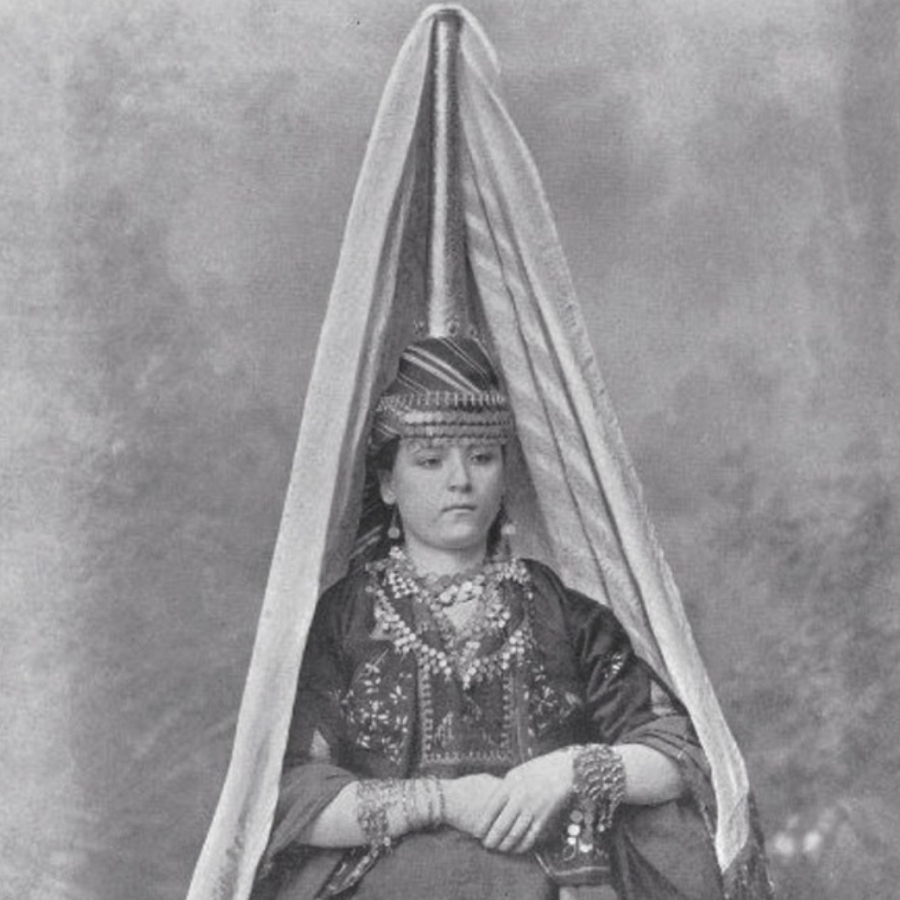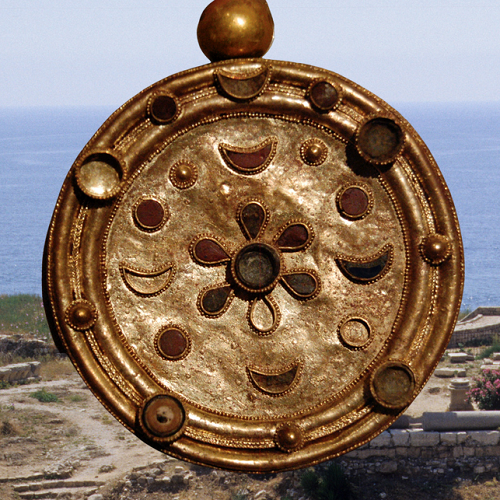In the blog series on jewellery, we will focus on the jewellery traditions of various countries in North Africa and South-West Asia. These jewellery traditions go further back in history than the geographical borders we know today, and of course, one country may be home to several cultural traditions. Both the historical context and the cultural heritage of a variety of peoples are visible in the jewellery worn, and we hope to introduce this wider scope of adornment and dress to you. In this post, we will look at the long history of jewellery in Lebanon.
 Lebanon is famous for its cedars, which feature in the national banner. Image: Canva
Lebanon is famous for its cedars, which feature in the national banner. Image: CanvaCommunicating with beads
The geographical area currently known as Lebanon borders the Mediterranean, Syria, and Israel. It has always been part of the larger Syro-Palestinian cultural sphere, which is reflected in its jewellery. One of the earliest occurrences of adornment and the production of adornment in Western Asia is found in Lebanon. A few kilometres from Beirut lies Ksar ‘Akil, a rock shelter where people lived some 40,000 years ago. These people created beads of shell, and from the research, we learn of their preference for very white as well as colourful shells.
They selected shells specifically to create ornaments: the shells that were part of their food range are of other species. These Lebanese shell beads are among the oldest ornaments in the world, and are instrumental in understanding the development of cognitive capacities of humans: it is by decorating ourselves that we show awareness of how others see us.
 A bead from Tell Fadous-Kfarabida. Image: Damick & Woodworth 2015
A bead from Tell Fadous-Kfarabida. Image: Damick & Woodworth 2015Bronze Age trade
Again, it is beads that tell us about long-distance trade in the early Bronze Age, around 3000 – 2500 BCE. In Tell Fadous-Kfarabida, in the north of Lebanon, a small urban centre flourished. Cylinder seals, which were also worn as beads, tell us about organisation and administration, but the materials used are just as informative about long-distance trade. Seven unassuming steatite beads reveal a trade network that reached as far as the Indus Valley. On the site, no evidence for bead production was found, making it likely that these beads were traded.
And here again, their colours seem to have been significant: it’s the type of steatite that turns white when burned that seems to have been preferred. In the Middle Bronze Age, cast bronze beads have been found on various sites in Lebanon. Here, we see how Lebanon formed part of a wider world in the Levant: the Lebanese beads have been created using the same metallurgical practices such as alloy composition and techniques used. What metallurgical analyses do reveal however is the practice of reuse: lead has been added to the mix in some ornaments. Did the people who made these have difficulty accessing tin and copper, or could they simply not afford it?
 A gold disc found in Byblos. Image: Sigrid van Roode/Canva
A gold disc found in Byblos. Image: Sigrid van Roode/CanvaByblos
What is now Lebanon was located within the Egyptian sphere of influence for much of the Bronze and early Iron Age. The Egyptian court would send gifts to local rulers, and as the collection in the National Museum in Beirut shows, these were of very high quality. Egyptian style jewellery was also preferred by the non-elite, as the spread of relatively low-quality scarabs made of amethyst shows: these have been found throughout the southern Levant.
The city of Byblos was a major trading port on the Mediterranean and received ships from all over the sea, as well as trade routes that came from further inland. Here, a gold disc was found which shows us an example of cultural exchange around 4,000 years ago. The workmanship is Mesopotamian in technique, but not in execution. Perhaps this is the work of a local craftsman, who learned to work with granulation in the style of current-day Iraq. The disc is unique and no other parallels for the use of granulation in a similar item exist. While Byblos has revealed quite a lot of Egyptian or Egyptianising jewellery, this piece is neither.
 Phoenician face bead, bracelet and fibula. Images The Metropolitan Museum of Art, New York and Flourentzos & Vitobello 2009
Phoenician face bead, bracelet and fibula. Images The Metropolitan Museum of Art, New York and Flourentzos & Vitobello 2009Phoenicians
During the first millennium BCE, trade in the world as it was known then was dominated by the Phoenicians. From their main ports in Beirut, Sidon, and Tyre they established colonies throughout North Africa and Europe, with Carthage in current-day Tunis as one of their most famous cities which would become an empire of itself. Phoenician jewellery is heavily influenced by that of ancient Egypt, due to the origins of the Phoenicians in current-day Lebanon, which was very much influenced by ancient Egypt as we have seen.
Scarabs and scaraboids were often used, while a ring found in Cyprus depicts the Egyptian goddess Maat, representing world order and balance. Other influences, like that of the Aegean civilisations, are visible in the fibula shown here. The Phoenician bracelet shown on the right is also from Cyprus and combines a scarab with intricate braiding of gold wire. Very specific for Phoenician jewellery are the face-beads shown here: these have been found widely throughout the Mediterranean, for example also on Sardinia.
 A lady from Mount Lebanon wearing a tantour
A lady from Mount Lebanon wearing a tantourSilver jewellery from Lebanon
Vintage silver jewellery from Lebanon is surprisingly little studied or documented. As Lebanon forms part of a larger cultural sphere, much of the traditional jewellery may be hiding under a Syrian or Palestinian attribution. The Bedouin population for example extended into these neighbouring countries, as did the Kurds, and their jewellery is also worn in several countries. The Ottoman period also has left its mark on jewellery, adding to its uniformity at a glance.
What is recognisable as distinctly Lebanese is the head ornament called
tantour. This was worn by married women during the 19
th century and consisted of a silver cone from which a veil fluttered down. In richer families, the tantour could even be made of gold and be encrusted with precious stones.
The photograph shown here also reveals an amount of coin jewellery being worn on the headdress and over the chest, as well as a series of bracelets. With Lebanon being the home of the civilisation that brought us the alphabet as we know it today, and having a rich and varied history of intercultural exchange, its most recent traditional jewellery warrants much more research and publication, so that this heritage, too, can be appreciated and treasured.
This blogpost is based on
- Damick, A. & M. Woodworth 2015. Steatite beads from Tell Fadous-Kfarabida: A case study in early Bronze Age technology in Northern Coastal Lebanon, in Journal of Archaeological Science: Reports 3, pp. 603-614
- David, A. 2019. Uninscribed Amethyst Scarabs from the Southern Levant, in Bulletin of the American Schools of Oriental
Oriental: (Latin and Late Middle English Adjective: orientalis – From Orient; from Latin (noun): oriri – to rise; and oriors – East), anything of an Eastern origin in relationship to Europe – Asia. The word was first used in the context of territorialization between the late 3rd and early 4th Century CE. Research 381, pp. 57-81
- Flourentzos, P. & M.L. Vitobello 2009. The Phoenician gold jewellery from Kition, Cyprus, in ArcheoSciences 33, pp. 143-149 [direct link: https://journals.openedition.org/archeosciences/2135#tocto1n2]
- Jong, L. de 2010. Performing Death in Tyre: the Life and Afterlife of a Roman Cemetery in the Province of Syria, in American Journal of Archaeology Vol 114 no. 4, pp. 597-630
- Kuhn, S. et al. 2001. Ornaments of the earliest Upper Paleolithic: New insights from the Levant, in: PNAS 2001, vol 98 (13), pp. 7641-7646
- Limmer, A.S. 2007. The social functions and ritual significance of jewelry in the Iron Age II Southern Levant. PhD-thesis, University of Arizona
- Morr, Z. el & M. Mödlinger 2014. Middle Bronze Age Metal Artefacts and Metallurgical Practices at the Sites of Tell Arqa, Mougharet el-Hourriyeh, Yanouh and Kharihi in Lebanon, in Levant 46:1 pp 27-42





 Lebanon is famous for its cedars, which feature in the national banner. Image: Canva
Lebanon is famous for its cedars, which feature in the national banner. Image: Canva A bead from Tell Fadous-Kfarabida. Image: Damick & Woodworth 2015
A bead from Tell Fadous-Kfarabida. Image: Damick & Woodworth 2015 A gold disc found in Byblos. Image: Sigrid van Roode/Canva
A gold disc found in Byblos. Image: Sigrid van Roode/Canva Phoenician face bead, bracelet and fibula. Images The Metropolitan Museum of Art, New York and Flourentzos & Vitobello 2009
Phoenician face bead, bracelet and fibula. Images The Metropolitan Museum of Art, New York and Flourentzos & Vitobello 2009 A lady from Mount Lebanon wearing a tantour
A lady from Mount Lebanon wearing a tantour